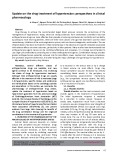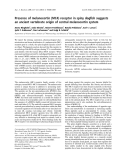
Systems pharmacology
-
Drug therapy to achieve the recommended target blood pressure remains the cornerstone of the management of hypertension. Today, there are strong evidences from randomized controlled trials that antihypertensive drugs are more effective than placebo at reducing cardiovascular mortality and morbidity.
 8p
8p  vifaye
vifaye
 20-09-2024
20-09-2024
 3
3
 1
1
 Download
Download
-
We report the cloning, expression, pharmacological char-acterization and tissue distribution of a melanocortin (MC) receptor gene in a shark, the spiny dogfish (Squalus acanth-ias) (Sac). Phylogenetic analysis showed that this receptor is anorthologof theMC4 subtype, sharing71%overall amino acid identity with the human (Hsa) MC4 receptor. When expressedandcharacterizedbyradioligandbindingassay for the natural MSH (melanocyte-stimulating hormone) pep-tides a-, b-, and c-MSH, the SacMC4 receptor showed pharmacological properties very similar to the HsaMC4 receptor. ...
 9p
9p  tumor12
tumor12
 20-04-2013
20-04-2013
 48
48
 3
3
 Download
Download
-
Regulated gene expression may substantially enhance gene therapy. Corre-lated with structural differences between insect ecdysteroids and mamma-lian steroids, the ecdysteroids appear to have a benign pharmacology without adversely interfering with mammalian signaling systems. Conse-quently, the ecdysone receptor-based gene switches are attractive for appli-cation in medicine.
 21p
21p  media19
media19
 04-03-2013
04-03-2013
 36
36
 5
5
 Download
Download
-
Disulfide pairings and active site residues are highly conserved in secretory phospholipases A2 (PLA2s). However, secretory PLA2 s of marine inverte-brates display some distinctive structural features. In this study, we report the isolation and characterization of a PLA2 from the northern Pacific sea anemone,Urticina crassicornis(UcPLA2), containing a C27N substitution and a truncated C-terminal sequence.
 13p
13p  mobifone23
mobifone23
 21-01-2013
21-01-2013
 35
35
 3
3
 Download
Download
-
Most evidence suggests that the major efferent limb of the inflammatory reflex is carried in: A. The sympathetic chain B. The phrenic nerve C. The vagus nerve D. Postganglionic sympathetics arising in the stellate ganglia E. The long thoracic nerve Correct Answer: The correct answer is C. Evidence suggests that information leaving the central nervous system regarding regulation of inflammation is carried mainly in the vagus nerve. The sympathetic chain is the origin of postganglionic fibers for sympathetic innervation of visceral organs.
 190p
190p  ozon_ozon
ozon_ozon
 03-05-2012
03-05-2012
 58
58
 4
4
 Download
Download
-
ON MONOTONICITY OF SOLUTIONS OF DISCRETE-TIME NONNEGATIVE AND COMPARTMENTAL DYNAMICAL SYSTEMS VIJAYSEKHAR CHELLABOINA, WASSIM M. HADDAD, JAMES M. BAILEY, AND JAYANTHY RAMAKRISHNAN Received 27 October 2003 Nonnegative and compartmental dynamical system models are widespread in biological, physiological, and pharmacological sciences. Since the state variables of these systems are typically masses or concentrations of a physical process, it is of interest to determine necessary and sufficient conditions under which the system states possess monotonic solutions.
 11p
11p  sting12
sting12
 10-03-2012
10-03-2012
 51
51
 4
4
 Download
Download
-
Delirium: Treatment Management of delirium begins with treatment of the underlying inciting factor (e.g., patients with systemic infections should be given appropriate antibiotics and underlying electrolyte disturbances judiciously corrected). These treatments often lead to prompt resolution of delirium. Blindly targeting the symptoms of delirium pharmacologically only serves to prolong the time patients remain in the confused state and may mask important diagnostic information. Relatively simple methods of supportive care can be highly effective in treating patients with delirium.
 5p
5p  ongxaemnumber1
ongxaemnumber1
 29-11-2010
29-11-2010
 66
66
 4
4
 Download
Download
-
Harrison's Internal Medicine Chapter 15. Headache Headache: Introduction Headache is among the most common reasons that patients seek medical attention. Diagnosis and management is based on a careful clinical approach that is augmented by an understanding of the anatomy, physiology, and pharmacology of the nervous system pathways that mediate the various headache syndromes. General Principles A classification system developed by the International Headache Society characterizes headache as primary or secondary (Table 15-1).
 5p
5p  ongxaemnumber1
ongxaemnumber1
 26-11-2010
26-11-2010
 90
90
 6
6
 Download
Download
-
Clinical Implications of Altered Bioavailability Some drugs undergo near-complete presystemic metabolism and thus cannot be administered orally. Nitroglycerin cannot be used orally because it is completely extracted prior to reaching the systemic circulation. The drug is therefore used by the sublingual or transdermal routes, which bypass presystemic metabolism. Some drugs with very extensive presystemic metabolism can still be administered by the oral route, using much higher doses than those required intravenously.
 4p
4p  tubreakdance
tubreakdance
 26-11-2010
26-11-2010
 93
93
 7
7
 Download
Download
-
Principles of Pharmacokinetics The processes of absorption, distribution, metabolism, and excretion— collectively termed drug disposition—determine the concentration of drug delivered to target effector molecules. Absorption Bioavailability When a drug is administered orally, subcutaneously, intramuscularly, rectally, sublingually, or directly into desired sites of action, the amount of drug actually entering the systemic circulation may be less than with the intravenous route (Fig. 5-2A ).
 8p
8p  tubreakdance
tubreakdance
 26-11-2010
26-11-2010
 109
109
 7
7
 Download
Download
-
Drugs Acting on Motor Systems spinal disorders. Benzodiazepines enhance the effectiveness of the inhibitory transmitter GABA (p. 226) at GABAA receptors. Baclofen stimulates GABAB receptors. !2-Adrenoceptor agonists such as clonidine and tizanidine probably act presynaptically to inhibit release of excitatory amino acid transmitters. The convulsant toxins, tetanus toxin (cause of wound tetanus) and strychnine diminish the efficacy of interneuronal synaptic inhibition mediated by the amino acid glycine (A).
 12p
12p  bigbaby87
bigbaby87
 04-09-2010
04-09-2010
 117
117
 10
10
 Download
Download
-
Inhibitors of the RAA System lasting effect than does captopril. Indications are hypertension and cardiac failure. Lowering of an elevated blood pressure is predominantly brought about by diminished production of angiotensin II. Impaired degradation of kinins that exert vasodilating actions may contribute to the effect. In heart failure, cardiac output rises again because ventricular afterload diminishes due to a fall in peripheral resistance.
 14p
14p  bigbaby87
bigbaby87
 04-09-2010
04-09-2010
 140
140
 11
11
 Download
Download
-
Drugs Acting on the Sympathetic Nervous System of the sympathetic division can be considered a means by which the body achieves a state of maximal work capacity as required in fight or flight situations. In both cases, there is a need for vigorous activity of skeletal musculature. To ensure adequate supply of oxygen and nutrients, blood flow in skeletal muscle is increased; cardiac rate and contractility are enhanced, resulting in a larger blood volume being pumped into the circulation. Narrowing of splanchnic blood vessels diverts blood into vascular beds in muscle.
 29p
29p  bigbaby87
bigbaby87
 04-09-2010
04-09-2010
 171
171
 16
16
 Download
Download
-
Adverse Drug Effects premature breakdown of red blood cells (hemolysis) in subjects with a glucose6-phosphate dehydrogenase deficiency. The discipline of pharmacogenetics deals with the importance of the genotype for reactions to drugs. The above forms of hypersensitivity must be distinguished from allergies involving the immune system (p. 72). Lack of selectivity (C). Despite appropriate dosing and normal sensitivity, undesired effects can occur because the drug does not specifically act on the targeted (diseased) tissue or organ.
 8p
8p  bigbaby87
bigbaby87
 04-09-2010
04-09-2010
 130
130
 15
15
 Download
Download
-
Adrenocortical steroids and their synthetic analogues Mechanisms of action Actions: mineralocorticoid, glucocorticoid Individual adrenal steroids Pharmacokinetics Dosage schedules Choice of adrenal steroid Adverse effects of systemic pharmacotherapy Adrenal steroids and pregnancy Precautions during chronic therapy: treatment of intercurrent illness Dosage and routes of administration Indications for use Uses: replacement therapy, pharmacotherapy Withdrawal of pharmacotherapy . Inhibition of synthesis of adrenal steroids. Competitive antagonism .
 17p
17p  bigbaby87
bigbaby87
 03-09-2010
03-09-2010
 79
79
 13
13
 Download
Download
-
The liver is the most important organ in which drugs are structurally altered. Some of the resulting metabolites may be biologically inactive, some active and some toxic (see Chapter 7).The liver is exposed to drugs in higher concentrations than are most organs because most are administered orally and are absorbed from the gastrointestinal tract.Thus the whole dose must pass through the liver to reach the systemic circulation.
 10p
10p  bigbaby87
bigbaby87
 03-09-2010
03-09-2010
 916
916
 10
10
 Download
Download
-
Neoplastic disease In most cases, the cause of cancer is multifactorial. About 75% of cancers are due to environmental factors, some of which are within the control of the individual, e.g. tobacco smoking, exposure to sunlight. Growing understanding of cancer genetics and inherited disease suggests that fewer than 10% of cancers are familial.The different systemic modalities used to treat cancer patients are discussed. Immunosuppressive drugs are described here as they share many characteristics with cytotoxics. ...
 19p
19p  bigbaby87
bigbaby87
 03-09-2010
03-09-2010
 101
101
 11
11
 Download
Download
-
Occlusive vascular disease is a major cause of morbidity and mortality.There is now better understanding of the mechanisms by which the haemostatic system ensures blood remains fluid within vessels, yet forms a solid plug when a vessel is breached, and of the ways in which haemostasis may be altered by drugs to prevent or reverse (lyse) pathological thrombosis.
 22p
22p  bigbaby87
bigbaby87
 03-09-2010
03-09-2010
 70
70
 11
11
 Download
Download
-
Overdose, including self-poisoning, causes bradycardia, heart block, hypotension and low output cardiac failure that can proceed to cardiogenic shock; death is more likely with agents having membrane stabilising action (see Table 23.1). Bronchoconstriction can be severe, even fatal, in patients subject to any bronchospastic disease; loss of consciousness may occur with lipid-soluble agents that penetrate the central nervous system. Receptor blockade will outlast the persistence of the drug in the plasma. Rational treatment includes: • Atropine (1-2 mg i.v.
 18p
18p  bigbaby87
bigbaby87
 03-09-2010
03-09-2010
 97
97
 11
11
 Download
Download
-
Acetylcholine is a widespread chemotransmitter in the body, mediating a broad range of physiological effects.There are two distinct classes of receptor for acetylcholine defined on the basis of their preferential activation by the alkaloids, nicotine (from tobacco) and muscarine (from a fungus, Amanita muscaria). Cholinergic drugs (acetylcholine agonists) mimic acetylcholine at all sites although the balance of nicotinic and muscarinic effects is variable.
 15p
15p  bigbaby87
bigbaby87
 03-09-2010
03-09-2010
 63
63
 5
5
 Download
Download
CHỦ ĐỀ BẠN MUỐN TÌM
































